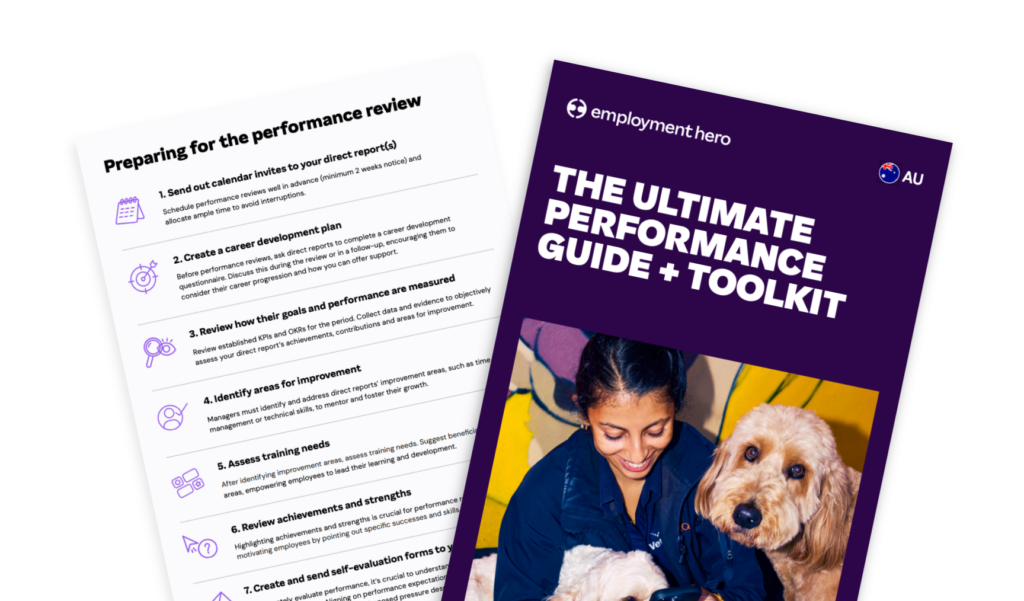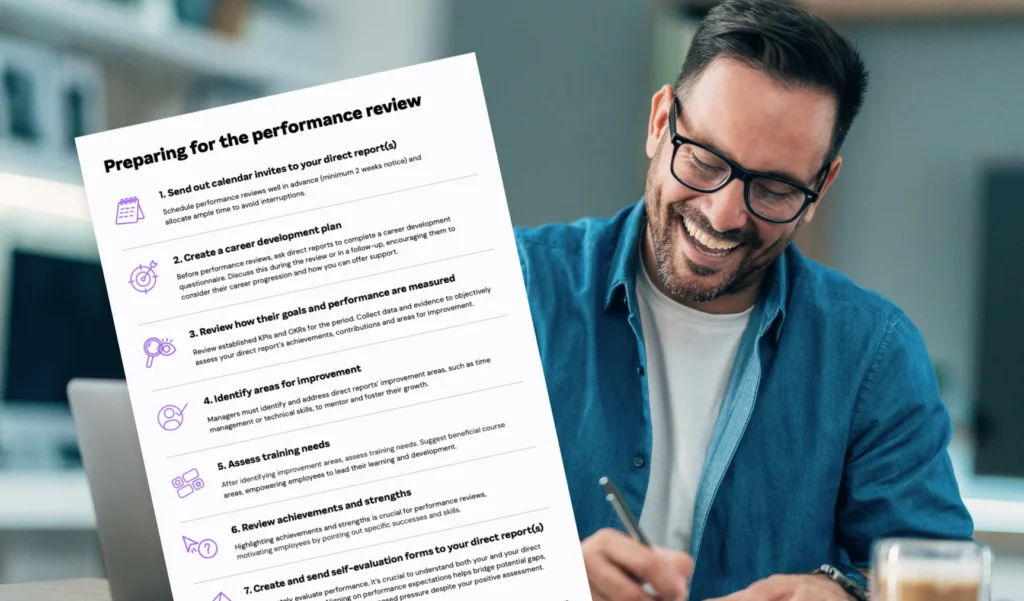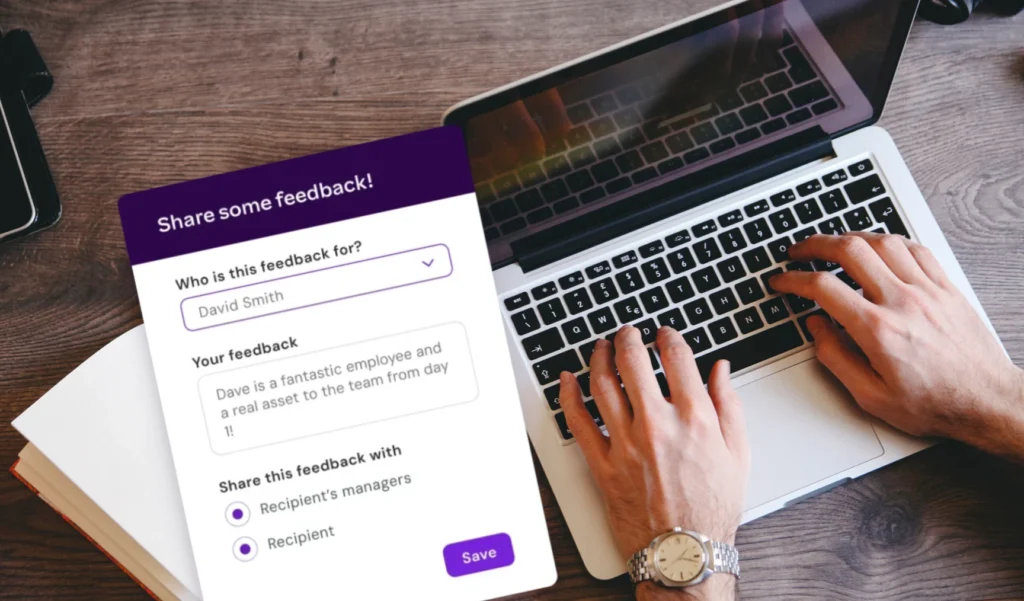Performance reviews for employees
Published
Performance reviews for employees
Get started on effective performance review planning today with our comprehensive guide and toolkit.

The traditional performance review is officially retired. That once-a-year meeting, loaded with paperwork and awkward conversations, simply doesn’t cut it for ambitious Australian businesses. It’s an outdated system that often leaves managers frustrated and employees feeling undervalued, failing to inspire real development at work. These days, workplaces operate on a different engine. One fueled by continuous development and open lines of communication.
Download our Ultimate Performance Guide and Toolkit using the form on the right.
When your team has a clear line overview of how their performance is tracking (such as what they’re mastering and where they can improve), that’s when clear development pathways can be created.
Treat this guide as your new performance review playbook, designed to help you move beyond clunky review methods and to focusing on a process that drives genuine engagement, boosts productivity and builds a culture of continual development. We’ll give you the process, examples and tools to make performance reviews for employees something everyone can look forward to, not an administrative chore.
What’s inside the ultimate performance guide and toolkit?
Ready to transform your approach? This guide is packed with practical templates, frameworks and expert advice to overhaul your performance management system. When you download our complete toolkit, you’ll get everything you need to build a high-performing and driven team.
Here’s what you’ll get inside:
- Self-evaluation performance review template: Empower employees to take ownership of their development with a structured template for self-reflection and assessment.
- Professional development plan template: Create actionable roadmaps for growth by aligning employee aspirations with business objectives.
- 1:1 meeting template: Turn every check-in into a productive conversation with a template designed to guide effective one-on-one meetings.
- Performance improvement plan (PIP) template: Manage underperformance constructively and fairly with a clear, documented framework.
- Expert guidance: In-depth insights on delivering impactful feedback, implementing 360-degree reviews and creating a culture of continuous growth.
What is a performance review?
A performance review is a structured and scheduled conversation between an employee and their manager to formally assess performance over a specific period. Think of it as a deep dive into an employee’s contributions, strengths and areas for development. While a performance appraisal often focuses on a backward-looking evaluation against a set of standards, a modern performance review is a forward-looking, collaborative discussion aimed at fostering professional growth and development.
Unlike ongoing feedback, which happens informally and frequently, a performance review is a dedicated, documented event. Its purpose is to align the employee’s understanding of their performance with their manager’s, set clear goals for the future and identify the support needed to achieve them. It’s a chance to formally recognise achievements and have an open dialogue about career progression.
Why performance reviews matter
While there is no strict legal requirement in Australia to conduct formal performance reviews, they’re a key part of effective people management.
- Boosts engagement and motivation: Regular feedback demonstrates that you value your team’s contributions. When employees see how their work directly impacts company goals, their motivation and engagement skyrocket.
- Drives development and growth: Reviews are the perfect opportunity to identify skill gaps and training needs. This allows you to invest strategically in your team’s development, building a more capable and resilient workforce.
- Mitigates compliance risk: In Australia, documented performance discussions are crucial for procedural fairness, especially when managing underperformance. Under the Fair Work Act 2009, a clear and fair process is vital if disciplinary action becomes necessary.
- Informs reward and recognition: Objective performance data allows you to link salary reviews, bonuses and promotions directly to an employee’s achievements and impact, ensuring a fair and transparent reward system.
- Strengthens manager-employee relationships: A good review process fosters trust and open communication, turning managers into coaches invested in their team’s success.
The performance review process (step-by-step)

A successful performance review process is transparent, consistent and collaborative. It requires thoughtful planning from both the manager and the employee to ensure the conversation is productive. Follow these five steps to build a process that drives results.
Step 1: Preparation and expectation setting
Preparation forms the foundation of an effective performance review. Walking in unprepared sends a message that you aren’t invested in your employee’s development.
- Schedule in advance: Give your employee at least two weeks’ notice to allow ample time to prepare. Book a private space and allocate sufficient time (typically 60-90 minutes) to avoid feeling rushed.
- Gather performance data: Don’t rely on memory. Collect objective data from the entire review period. This includes progress against KPIs or OKRs, notes from 1:1 meetings, completed project outcomes and feedback from peers or clients.
- Define clear objectives: What is the primary goal of this review? Is it to discuss a potential promotion, address a performance gap or set goals for the next quarter? Communicate the purpose clearly in the meeting invitation.
Step 2: Self-evaluation and manager assessment
The best reviews involve a two-way exchange of information. Both the employee and manager should come to the meeting, having already reflected on the performance period.
- Employee self-evaluation: Ask your employee to complete a self-evaluation form before the meeting. This encourages them to reflect on their achievements, challenges and areas where they want to grow. It also provides a valuable starting point for the conversation.
- Manager assessment: Using the same framework, complete your own assessment of the employee’s performance. Compare your notes with their self-evaluation to identify areas of alignment and points for discussion. This helps remove bias and grounds the conversation in shared understanding.
Step 3: The review conversation
The review meeting itself should be constructive and collaborative. Consider talking through these key points.
- Start with strengths: Begin the conversation by highlighting the employee’s achievements and positive contributions. This sets a supportive tone and makes it easier to discuss areas for improvement later.
- Discuss the self-evaluation: Use the employee’s self-assessment as a guide. Ask open-ended questions like, “Tell me more about the project you were most proud of,” or “What challenges did you encounter with that task?”
- Listen actively: Make space for the employee to speak. A performance review should be a dialogue, with the manager listening as much as they talk. This ensures the employee feels heard and respected.
- Focus on behaviour, not personality: When discussing areas for improvement, be specific and objective. Use examples to illustrate your points without making personal judgments.
Step 4: Feedback and goal setting
The conversation must translate into a clear plan for the future. This involves providing balanced feedback and collaboratively setting meaningful goals.
- Provide balanced feedback: Offer both positive reinforcement and constructive feedback. Make sure that the feedback is specific, actionable and tied to observable behaviours and their impact.
- Collaborate on goals: Work together to set SMART (Specific, Measurable, Achievable, Relevant, Time-bound) goals for the next review period. These goals should align with both the employee’s career aspirations and the company’s strategic objectives.
- Create a development plan: Identify what support the employee needs to achieve their goals. This could include formal training, mentorship or new project opportunities. Document this in a professional development plan.
Step 5: Follow-up and continuous improvement
The performance review conversation doesn’t stop at the end of the meeting. Be sure to follow up next steps so your team can enter the next stage of professional growth.
- Document everything: Summarise the key discussion points, agreed-upon goals and the development plan. Share this document with the employee and save it in their official file. This creates a clear record of the conversation.
- Schedule regular check-ins: Don’t wait until the next formal review to discuss progress. Use regular 1:1 meetings to track progress against goals, offer support and provide timely feedback. This turns performance management into a continuous process.
How often should performance reviews be conducted?
The old-school annual review is quickly becoming obsolete. A once-a-year conversation is simply not enough to keep employees aligned and motivated. And while there’s no single right answer, most successful businesses are moving towards a more frequent cadence.
- Annual reviews: A traditional approach that provides a formal, comprehensive look at the year. However, it risks “recency bias” and can feel like a high-pressure event filled with surprises.
- Bi-annual reviews: Conducting reviews every six months provides more timely feedback and allows for quicker course correction. This cadence works well when paired with informal quarterly check-ins.
- Quarterly reviews: A popular choice for agile businesses, quarterly reviews ensure that goals remain relevant and that feedback is delivered when it’s most effective. This rhythm helps build a culture of continuous improvement.
The ideal frequency depends on your business size, industry and culture. The key is to supplement formal reviews with a culture of continuous feedback through regular 1:1s and informal check-ins. This ensures no surprises come review time.
How company size affects your performance review process
Your performance review process should evolve as your business grows. What works for a team of 15 won’t be sufficient for a company of 150.
- Startups and small businesses (under 15 employees): The process is often informal. The founder might conduct reviews ad-hoc. The focus is on agility and direct feedback, but it’s crucial to start documenting conversations to establish good habits.
- Growing businesses (15-75 employees): As teams expand, a more structured process becomes necessary. This is the stage to introduce formal review cycles (quarterly or bi-annually), self-evaluations and dedicated performance management software to keep consistency.
- Medium-sized businesses (75-150+ employees): At this scale, you need a robust, scalable system. This includes standardised templates, manager training, 360-degree feedback and clear links between performance, remuneration and career progression. HR software becomes essential to manage the administrative load.
Performance review templates and tools
Having the right tools can transform your performance review process from a burden into a strategic advantage. Our range of performance review resources are designed to give you a head start.
Our Performance Review Template provides a comprehensive framework for managers and employees. For a more focused approach, our Mid-Year Performance Check-In Template is perfect for less formal reviews. And to ensure you cover all your bases, use our Employee Performance Review Checklist.
Or download the Ultimate Performance Guide and Toolkit to get all this and more in the one resource.

Examples and phrases for performance reviews
Finding the right words can be one of the most challenging parts of a performance review. The goal is to be clear, specific and supportive. Here are some examples to help you craft your feedback.
Positive feedback examples
“Your work on the Q3 client report was outstanding. The insights you provided helped us secure a contract extension. Great job.”
“I’ve been consistently impressed with your ability to collaborate with the engineering team. You’ve built strong relationships that are making our projects run more smoothly.”
“Thank you for taking the initiative to mentor our new junior developer. Your guidance has made a significant positive impact on their onboarding experience.”
Constructive feedback examples
“I’ve noticed that on several recent projects, deadlines were missed by a few days. Let’s work together on a strategy to better anticipate potential delays and manage timelines more proactively.”
“During team meetings, I’ve observed that you sometimes hesitate to share your perspective. Your ideas are valuable, and I encourage you to contribute more actively so the team can benefit from your insights.”
“While your technical reports are thorough, they can be difficult for non-technical stakeholders to understand. Let’s brainstorm ways to simplify the language to make the key takeaways clearer for a wider audience.”
Phrases by competency
Communication: “Articulates ideas clearly and persuasively.” or “Could improve on listening actively during team discussions.”
Problem-solving: “Consistently identifies root causes and develops effective, creative solutions.” or “Tends to focus on surface-level fixes rather than addressing the core issue.”
Teamwork: “Actively supports colleagues and contributes to a positive team environment.” or “Could be more proactive in offering assistance to team members during busy periods.”
Leadership: “Inspires and motivates the team to achieve ambitious goals.” or “Needs to delegate tasks more effectively to empower team members.”
How to give great feedback during performance reviews

Effective feedback is the heart of a great performance review. It should be a two-way conversation that is specific, balanced and forward-looking. One powerful framework for delivering clear and objective feedback is the Situation-Behaviour-Impact (SBI) model.
- Situation: Describe the specific context. Where and when did it happen? (e.g., “During the project kickoff meeting last Tuesday…”)
- Behaviour: Describe the exact, observable behaviour without judgment. (e.g., “…you presented the project timeline clearly and confidently.”)
- Impact: Explain the consequence of that behaviour on you, the team or the business. (e.g., “…which made everyone feel aligned and excited about the project.”)
Using this framework helps remove emotion and judgment, allowing you to focus on the facts and their consequences.
Turning performance reviews into actionable feedback
A review is only valuable if it leads to action. The goal is to move from discussion to a concrete plan for development.
- Focus on the ‘how’: Don’t just identify a weakness; create a plan to address it. If an employee struggles with time management, the goal isn’t “get better at managing time.” It’s “Implement the Pomodoro Technique for all deep work sessions and use a digital task manager to track daily priorities,” with a check-in scheduled in two weeks.
- Co-create action steps: Work with the employee to define what success looks like and the steps needed to get there. This fosters ownership and commitment.
- Connect to business goals: Ensure that development goals are not just personal but also align with what the business needs. This makes the employee’s growth a direct contributor to the company’s success.

Best practices for effective performance reviews
While best-practice will look different for every business based on your size, priorities and available resources for performance reviews, here is a list of the core components you’ll need for the best employee and business outcomes.
- Train your managers: Don’t assume managers instinctively know how to conduct great reviews. Provide training on goal setting, giving feedback and coaching.
- Separate pay from performance talks: While performance should inform compensation, mixing the two conversations can cause development goals to be overlooked. Hold the performance review first, focus on growth and have a separate, shorter meeting to discuss salary changes.
- Eliminate surprise: A formal review should never contain new information. Important feedback, especially if it’s constructive, should be delivered in real-time through regular check-ins.
- Document everything: Keep detailed, objective records of conversations, goals and outcomes. This is critical for fairness, consistency and compliance.
- Use technology: Use performance management software to streamline the process, store data and track progress. This allows managers to focus on the human side of the conversation.
Do it all with performance management software
Don’t let outdated, manual systems slow down your progress. The right software can completely transform your approach to performance reviews; freeing you from paperwork and chasing emails, and let you do what matters: develop your people and drive business growth.
Employment Hero’s performance management software does the heavy lifting for you. You get:
- Centralised performance data: Access everything in one place, from goals and feedback to 1:1 notes and formal review outcomes.
- Automated reminders and workflows: Stay ahead of review cycles without endless admin.
- Real-time feedback and 360 reviews: Encourage a culture of open, continuous feedback with tools that support real conversations and actionable insights.
- Easy tracking and reporting: Monitor progress, identify trends and act fast on what needs attention. No more waiting for the next review cycle.
- Full visibility for managers and employees: Empower everyone to take ownership of their development, with clear records and easy-to-use templates.
Upgrade your process with Employment Hero’s performance management platform and unlock the potential of your team. Fill in the form and download our Ultimate Performance Guide and Toolkit.
Frequently asked questions
A performance appraisal is typically a top-down, backward-looking evaluation of an employee’s performance against a set of standards. A performance review is a more collaborative, forward-looking conversation focused on development, goal setting and two-way feedback.
Avoid discussing personal issues unless they directly impact workplace performance. Never introduce surprise criticisms, make comparisons to other employees or provide vague, non-actionable feedback. The focus should remain professional, objective and constructive.
Preparation is key. Gather specific, documented examples of the performance issues. Use the SBI model to frame your feedback. Plan your talking points, anticipate the employee’s reaction and stay calm and objective. Focus on the path to improvement, not just the problem.
To mitigate bias, base your assessment on objective data and specific examples collected over the entire review period. Avoid “recency bias” (over-focusing on recent events) and “halo/horns effect” (letting one positive or negative trait overshadow everything else). Using a standardised review template and incorporating 360-degree feedback can also help.
A typical performance review meeting should be scheduled for 60 to 90 minutes. This provides enough time for a thorough, unhurried discussion without causing fatigue.
Schedule the review at least two weeks in advance. This gives both the manager and the employee adequate time to prepare their thoughts, complete the self-evaluation and gather relevant data.























